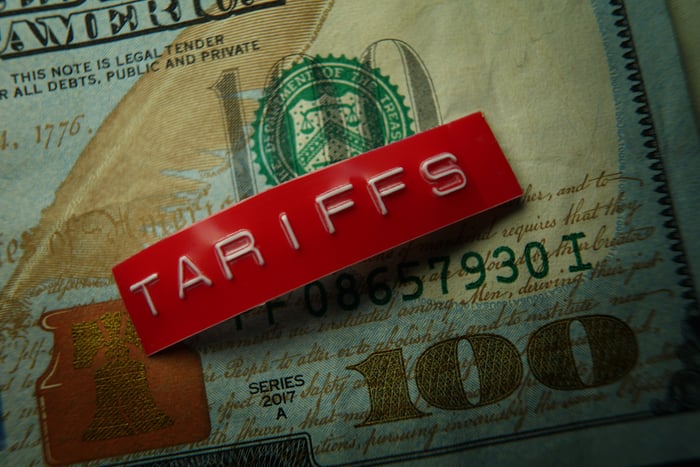Not long after my 18th birthday, I opened my first brokerage account with E*TRADE. In just a few months, I'll be celebrating my 27th year as an investor, and my 28th, in total, following what makes stocks and the market tick.
I can say, without question, there's always something new to learn and a stock that can prove a person wrong.
For example, I've been decisively skeptical of the face of the artificial intelligence (AI) revolution, Nvidia (NVDA 0.87%). All Nvidia has done is blow naysayer commentary out of the water and tack on more than $3 trillion in market cap since 2023 began. Nvidia's Hopper (H100) and Blackwell graphics processing units (GPUs) have been the undeniable top options by businesses operating AI-accelerated data centers.

Image source: Getty Images.
But I've also seen stories like Nvidia's play out before. While the hype surrounding game-changing innovations can appear insurmountable, there are tangible, historical, and statistical reasons to believe Nvidia is, indeed, fallible.
What follows are 10 reasons to pass on Nvidia stock from an investor who's seen a lot of next-big-thing trends come and go over 27 years.
1. Next-big-thing trends go hand in hand with early stage bubbles
History offers one the most compelling reasons to keep your distance from Nvidia stock. Since (and including) the advent of the internet in the mid-1990s, every major technological leap forward has resulted in an early stage bubble eventually (keyword!) forming and bursting. Although it's impossible to know when this bubble will burst ahead of time, next-big-thing trends and bubbles have gone hand-in-hand for more than three decades.
The simple fact that most businesses haven't yet optimized their AI solutions and aren't generating a profit on their AI investments strongly suggests that investors have, once again, overestimated the adoption rate and early innings utility of a game-changing innovation. That's bad news for Nvidia.
2. External competitors are ramping up production
Though Nvidia accounts for a near-monopoly like share of the GPUs currently deployed in AI accelerated data centers, it's unlikely to stay that way for long. Nvidia's has sold all the GPUs it can for 2025, which means hardware-hungry businesses will look elsewhere to gain an edge.
External providers like Advanced Micro Devices (AMD -0.20%) are rapidly ramping up production and introducing new AI-accelerating chips. AMD's Instinct series chips are notably cheaper and more readily accessible than Nvidia's hardware, which suggests it should have no issue chipping away (pun fully intended) at Nvidia's leading data center market share.
3. Internal competition will remove valuable data center real estate
However, the argument can be made that internal competition is an even bigger threat to Nvidia's future -- and one of the top reasons to pass on its stock.
Many of Nvidia's top clients by net sales are internally developing AI-GPUs and solutions to use in their data centers. While these chips won't be competing against Hopper and Blackwell externally, they will be taking up valuable data center real estate that Nvidia won't be able to win. Further, the internally developed hardware by Nvidia's leading customers is considerably cheaper than Hopper and Blackwell.
4. CEO Jensen Huang's innovation cycle could be disruptive to his own company
Normally, innovation is everything for tech companies. Nvidia CEO Jensen Huang is sparing no expense to ensure that his company maintains its compute advantages. Huang is attempting to bring a new advanced AI-GPU to market annually, with Blackwell Ultra debuting later this year, followed by Vera Rubin and Vera Rubin Ultra in 2026 and 2027, respectively.
The concern is that Huang's accelerated innovation cycle will quickly depreciate prior-generation chips and coerce businesses to trade down to less-costly options. Bringing a new chip to market annually might also irritate key customers, which may choose to delay their upgrade cycles.
NVDA Gross Profit Margin (Quarterly) data by YCharts.
5. Its gross margin is already eroding
Nvidia's biggest competitive edge in AI has been its ability to exploit AI-GPU scarcity. As long as GPU demand overwhelms supply, Nvidia can notably increase its prices, boost its production, and benefit from both ends.
But we're already observing evidence that AI-GPU scarcity is waning. Although world-leading chip fabrication company Taiwan Semiconductor Manufacturing still can't satiate demand despite rapidly expanding its chip-on-wafer-on-substrate capacity, Nvidia has delivered four consecutive quarters of declining generally accepted accounting principles (GAAP) gross margin. While the company expects a modest rebound in GAAP gross margin for the current quarter, this four-quarter decline points to external and internal competition reducing the AI-GPU scarcity Nvidia holds so dear.
6. Export restrictions are choking off a key market
Another reason to consider passing on Nvidia stock is because of ongoing export restrictions to China, which is one of the company's most important individual markets and generates billions of dollars in quarterly sales.
What makes export restrictions on high-powered AI chips so unique is that it's one of the few policies the Joe Biden administration and Donald Trump administration have seen eye-to-eye on. For three years, the federal government has stymied exports of Nvidia's top AI hardware to the world's No. 2 economy. With President Trump focused on national security and making the U.S. an artificial intelligence leader, it seems highly unlikely that these restrictions will be eased anytime soon.

Image source: Getty Images.
7. Tariffs are a secondary threat to margins
In addition to Nvidia having key products restricted for export to China, President Trump's tariff and trade policy threatens to throw a monkey wrench into the company's expansion plans.
Implementing a sweeping global tariff, along with higher "reciprocal tariff rates" for select countries that have historically had adverse trade imbalances with America, runs the risk of worsening trade relations with key partners, and may incite anti-American sentiment toward certain goods. To boot, tariffs may be placed on semiconductors and/or various aspects of the AI supply chain, which can ultimately weaken Nvidia's gross margin.
8. Insiders haven't made a purchase in over 54 months
If you need another tangible excuse to pass on Nvidia stock, look no further than the company's insider trading activity, which is required to be filed with the Securities and Exchange Commission.
In December 2020, two sons of Chief Financial Officer Colette Kress each purchased 100 shares of Nvidia. This purchase, which occurred more than 54 months ago, is the last time an executive, board member, or direct family member, bought shares. In comparison, there have been 172 separate sales by insiders since Kress's Form 4 was filed in 2020.
While there are plenty of reasons to sell a stock (not all of which are worrisome), there's only one reason to buy: you believe shares will head higher. If Nvidia's insiders aren't buying, why should you?
9. Billionaires have been persistent sellers of Nvidia stock
With one exception -- billionaire Chase Coleman of Tiger Global Management -- Wall Street's brightest billionaire money managers have been persistent sellers of Nvidia stock for more than a year. This includes Stanley Druckenmiller of Duquesne Family Office and Stephen Mandel of Lone Pine Capital, both of which completely exited their once sizable positions in this AI kingpin.
Though billionaire investors are fully capable of being wrong, it's noteworthy that an overwhelming majority of big-money hedge funds have cashed in their chips or meaningfully reduced their positions, as is the case with David Tepper of Appaloosa, Philippe Laffont of Coatue Management, and Israel Englander of Millennium Management. Some of the above factors may have played a role in their decisions to sell or reduce their exposure.
NVDA PS Ratio data by YCharts. PS Ratio = price-to-sales ratio.
10. A key aspect of Nvidia's valuation still makes no sense
Last but certainly not least, Nvidia's valuation isn't all it's cracked up to be. While its forward price-to-earnings ratio of 25 isn't egregiously high, its trailing-12-month (TTM) price-to-sales (P/S) ratio of 24 remains in nosebleed territory, relative to other megacap stocks that have been on the leading edge of next-big-thing trends.
For instance, key players in the evolution of the internet, such as Amazon, Microsoft, and Cisco Systems, all topped out with TTM P/S ratios ranging from 30 to 43 before the dot-com bubble burst. Perhaps not coincidentally, Nvidia's TTM P/S ratio peaked at 42 last summer. Nevertheless, a P/S ratio of 24 is still far too high, based on historical data, to be sustainable.







